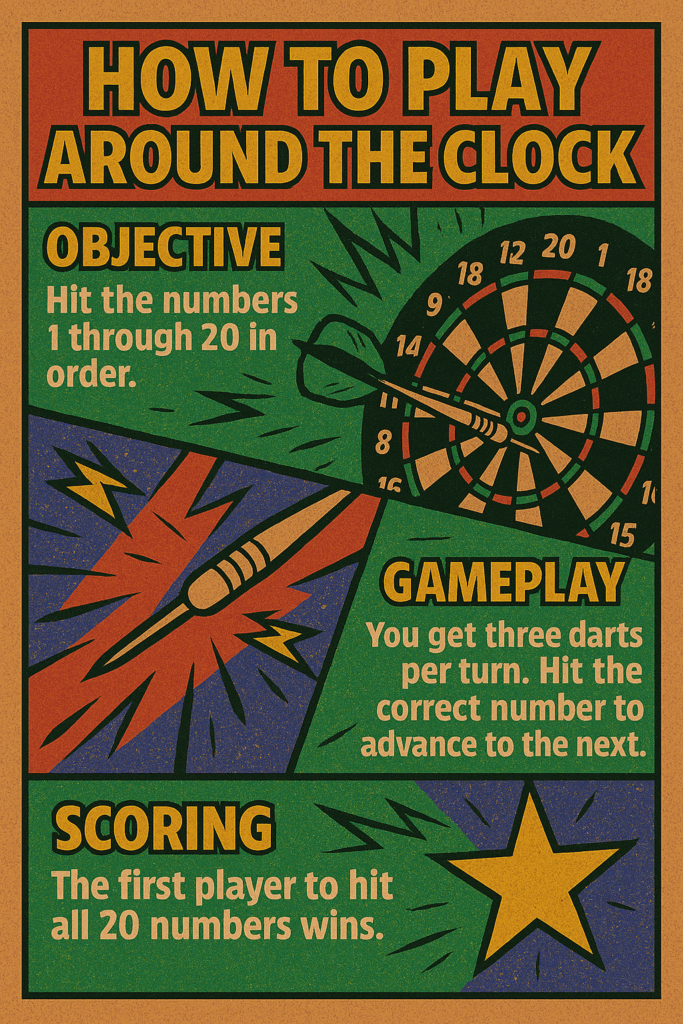Below is my personal take on the Round the Clock (Variation)—which is closely related to “Around the Clock” but with extra twists. I’ll share how I play it with friends, the rules we use, plus tips and handicap ideas from my own experience.
My Introduction to the Variation
I first stumbled upon this variation when a friend insisted that hitting singles in a standard “Around the Clock” felt too easy. He wanted a version that forced us to aim for doubles, trebles, or even bullseye steps along the path. We called it “Advanced Round the Clock.” Ever since, it’s been a staple in our practice sessions—perfect for improving consistency on specific segments.

How This Variation Works
- Objective
- Like the classic Around the Clock, the main goal is to move through a sequence of targets on the dartboard (usually 1 through 20, then bull).
- The difference here is which segments you’re allowed or required to hit.
- Possible Variations
- Doubles Only: You must hit Double 1 before moving on to Double 2, then Double 3, etc., all the way to Double 20. Finally, you finish with a Double Bull or single Bull.
- Trebles Only: Same concept, but for Treble 1 through Treble 20, then possibly the bull.
- Mixed Sequence: A hybrid approach—maybe 1 (any hit), then Double 2, Treble 3, Double 4, Treble 5, etc. This can be decided before you start.
- Turns and Progression
- Each player gets three darts per turn. If you succeed in hitting your current target (e.g., Double 4), you immediately move on to the next (Double 5) within the same turn.
- If you miss your target with all three darts, you stay on that number, waiting for your next turn.
- Winning
- The winner is the first to complete the final target (often Double 20 or Bull).
Personal Experiences and Anecdotes
- Getting Stuck on Certain Doubles
I quickly learned that certain doubles or trebles—like Double 11 or Treble 19—can feel trickier than others, especially from muscle-memory perspective. One night, I watched everyone fly through Treble 1 to Treble 5, but I was stranded on Treble 6 for at least four rounds (embarrassing, but a good lesson in aim adjustments). - Epic Streaks
One of my favorite memories is when I caught fire one evening and hit Double 15, Double 16, Double 17, and Double 18 all in a single turn. It felt like I couldn’t miss. My friends jokingly demanded a doping test for “performance-enhancing focus.” Of course, I immediately got humbled the next round by Double 19!
Tips & Tricks
- Practice the Standard Variation First
- If you’re new to “Around the Clock,” it might help to start with the basic version (singles allowed) before jumping into doubles or trebles only.
- Use a Spotting Dart
- Similar to other games, I often throw my first dart to “find” the number, even if it’s in the single segment, then adjust my second or third dart to aim for the required double/treble.
- Focus on Muscle Memory
- This variation is all about hitting specific thin segments. It’s a great way to train your throw for the smaller sweet spots on the board. Repetition builds that mind-muscle connection.
- Stay Loose
- When I get frustrated, I tense up and my darts start flying erratically. A brief mental reset—like stepping back, taking a breath—can help me relax and throw more accurately.
Handicap Ideas
Because this version can be challenging, especially for beginners, here are ways to even out the playing field:
- Different Start Points
- Let beginners start from Double 1, while advanced players start from Double 5 or Double 10. This means the pros have more targets to conquer.
- Allow Singles for Newcomers
- If novices are playing the “Doubles Only” variation, let them advance by hitting any part of that number (single, double, or treble). More experienced players must stick to the specific double/treble.
- Extra Dart
- Give beginners a fourth dart each turn, offering more chances to clear a tricky segment. Once they hit the target, the remaining darts can still be used to chase the next one.
- Shorten the Sequence
- Instead of going 1 to 20, maybe stop at 10 or 12. If advanced players want more challenge, they do the entire sequence (1–20), while beginners do 1–10.
- Bull Optional
- The bullseye is a notoriously tough final target. For novices, consider making the final target Double 20 only, while advanced players must finish on the bull.
Why I Love This Variation
Round the Clock (in its “advanced” forms) really polishes your precision. Moving around the board keeps things interesting, and having to hit doubles or trebles adds that extra level of challenge. Whenever my friends and I want to push our skills—yet still keep a fun, friendly atmosphere—this is the game we choose.
The potential for dramatic comebacks is huge: one player might streak through several doubles in a single turn, skipping ahead multiple numbers. Conversely, a hot hand can suddenly go cold on something like Double 9, opening the door for someone else to catch up. That element of unpredictability is what makes it so enjoyable.
If you’re looking to sharpen your aim beyond just nailing 20s, give Round the Clock (Variation) a try. It offers fresh challenges each step of the way and can be scaled for different skill levels. Just prepare for moments when your best friend nails three doubles in a row—trust me, you’ll hear about it for the rest of the night!
